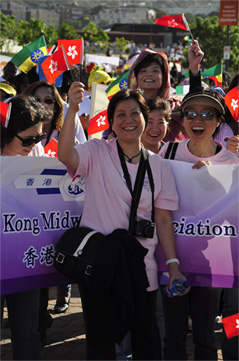News
Durban Congress Highlights the Vital Role of Midwives
- 20 June 2011
News
DURBAN, South Africa – More midwives are needed worldwide, and adequate numbers of midwives could save 3.6 million lives a year. These are some of the conclusions put forward in the State of the World’s Midwifery 2011: Delivering Health, Saving Lives – the first global report to examine the midwifery profession in more than 30 years. The report was released today by UNFPA at the 29th Triennial Congress of the International Confederation of Midwives.
“Midwives are central to the achievement of all three health-related MDGs – 4, 5 and 6—to reduce child mortality, improve maternal health and combat AIDS, tuberculosis and malaria,” said UNFPA’s Executive Director, Babatunde Osotimehin, in a televised message at the launch. “For our part at UNFPA, the United Nations Population Fund, we are supporting countries to train and deploy midwives where they are needed.”
More than a report, the State of the World’s Midwifery 2011: Delivering Health, Saving Lives was described as a unifying force that will help bring midwives together.
“As midwives we personify the whole SRHR [sexual and reproductive health and human rights] agenda,” said Anneka Knutsson, representing the Swedish Development Cooperation Agency, SIDA. “This report is an important marker as it places midwives at the center of attention and provides information we need as agents of change.”
Ms. Knutsson’s support was echoed by Carol Presern, Director of the Partnership for Maternal, Newborn and Child Health, who praised the report and called supporting midwives “a great investment.”
In addition to the report, today marked the launch of Stories of Midwives, a multimedia exhibition produced by the White Ribbon Alliance that showcases the role of midwives around the world.
A day earlier, the official opening of the Congress felt more like a concert than the opening of a midwifery conference as young Africans danced to drumbeats and children proudly carried the flags of more than 100 nations down the aisle, revelling in the applause of 3,000 midwives.
“Midwives will no longer be invisible,” they chanted.

During the ceremony, the President of the International Confederation of Midwives (ICM), Bridget Lynch, celebrated the huge strides happening in the field of midwifery and singled out the work done by ICM’s partners, particularly UNFPA. She called it a ‘sibling relationship’ and thanked the Fund for everything it had done to develop the Joint ICM-UNFPA Programme.
“During this last triennium, the programme has been developed to deliver education, regulation and strengthened midwifery services in 23 countries across Africa, Asia, Latin America and the Caribbean,” she said, adding that the upcoming report will be an important tool to improve access to midwifery care globally.
The audience also heard several key health personalities highlight the importance of midwifery to the health of women, including South Africa’s Deputy Minister of Health, Dr. Gwendoline Ramakgopa.
The opening ceremony followed a 5-kilometre march along the Durban beachfront the previous day to draw attention to the lack of midwives in the world.
“We are marching because we want to bring midwives to the attention of the world,” said Hasima from Bangladesh, as the crowds flowed by. Judith from New Zealand called the gathering ‘magical.’ “Here I am, marching with other midwives from around the world in South Africa – that to me represents the world.”
Participants were excited about today’s release of the landmark State of the World’s Midwifery 2011, which provides new information and data gathered from 58 countries across all regions to help strengthen the practice of midwifery on a global scale.
The role of skilled birth attendants – especially midwives – is widely acknowledged as being critical to addressing maternal and newborn death and disability. However, recent analyses show that there are far too few midwives and that both midwifery personnel and services are unequally distributed among and within countries. Certain countries will have to double or triple their number of midwives if they hope to achieve 95 per cent coverage of deliveries by a skilled birth attendant.
The global report documents the situation in countries with high maternal and newborn death and contributes to the implementation of the Global Strategy for Women’s and Children’s Health.